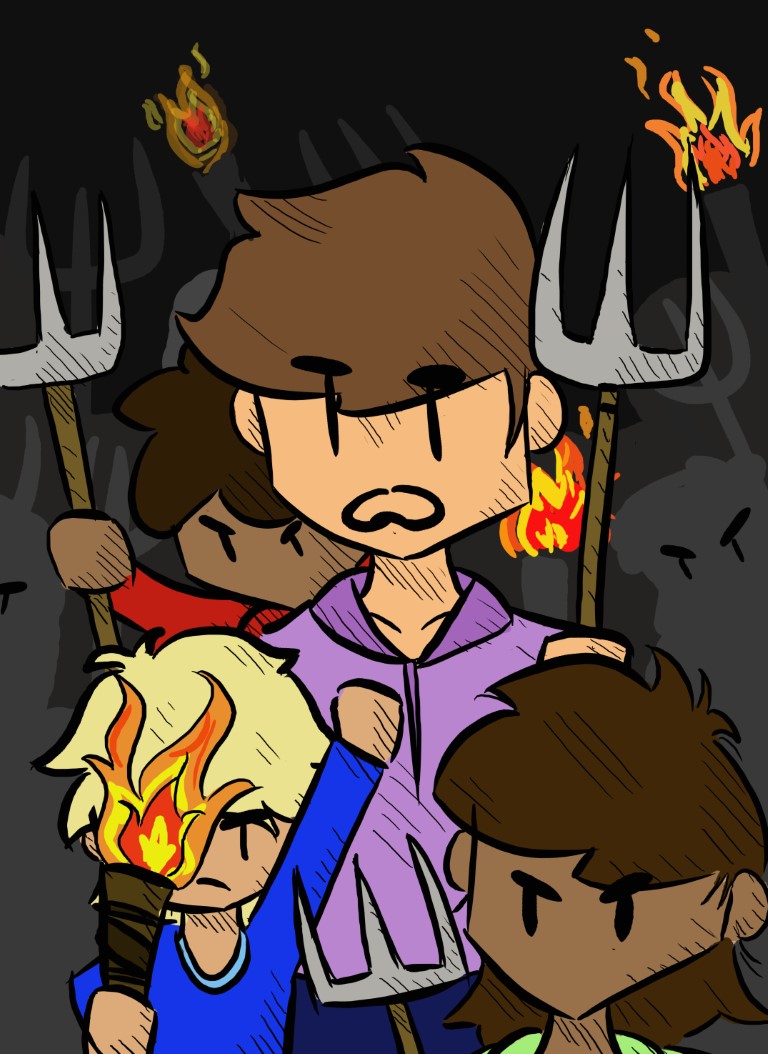
Are humans predisposed to starting riots?
By Janis McMath, Editor-in-Chief
People can procure miracles when they work together; there is no doubt that we need one another to succeed. A few examples of this teamwork include activist movements, charitable organizations, education systems, and hospital systems. Many of humankind’s greatest achievements could only be accomplished through collaboration. Yet this principle—that there is power in numbers—often works against us. Hordes of people with ill-intent can easily cause destruction. What is it in our nature that makes us so susceptible to a “herd mentality”?
WE LOVE TO COPY OTHERS
And not just on quizzes and tests. Many studies have shown that humans have an
undeniable tendency to mirror the status quo, regardless of our initial
feelings; one famous example of this being the Asch conformity studies from the 1950s. Participants were given a card with
images of multiple lines. They were then asked to distinguish which lines were
the same length. When participants were in the control situation, where they answered
the questions by themselves, they answered incorrectly less than one
percent of the time. In the experimental situation—where research participants
were (unknowingly) put amongst a group of actors who were all instructed to
pick the incorrect answer—75 percent of participants felt the sway of the group
and answered incorrectly at least one time. A shocking 37 percent of participants
gave the wrong answer every single time as the group did.
While five-year-olds did not change their opinion when told their ratings differed from that of their peers, six-year-olds conformed to what their peers stated.
While you may think that copying what others say about a line length is trivial, a study (Morality and conformity: The Asch paradigm applied to moral decisions) using the same techniques as the Asch conformity experiments, which instead focused on moral decisions, also proved to show a “pronounced effect of conformity.” When answers on moral decisions were compared between the controlled condition participants that answered alone and those in the experimental condition with the group of lying actors, the study showed that people often changed their opinion to match the common consensus.
This apparent preference to replicate what others are doing isn’t a problem exclusive to adults either—it is even seen in children as young as six-years old! A study (Social conformity persists at least one day in 6-year-old children) done with both five- and six-year-olds involving rating attractiveness of faces showed that while five-year-olds did not change their opinion when told their ratings differed from that of their peers, six-year-olds conformed to what their peers stated. When asked again about attractiveness ratings the next day, six-year-olds still showed a conformity to what they were told was the norm. Mobs love to tell people what to think; people listen when others tell them what to think. It’s a natural match.
WE’RE AWFUL WHEN ANONYMOUS
YouTube commenters are jerks, and science can explain why. The term “deindividuation” explains the behaviour of these anonymous message board trolls; when people are put into situations where they are anonymous—for example in a large group—they act in ways that they never would otherwise. For example, a study conducted by Edward Diener in 1976 focused on the actions of trick-or-treaters. In the study, researchers set up several different scenarios to test the effects of deindividuation of the behaviour of children taking candy from an unsupervised bowl. In one case, children were asked to put their names and addresses down before getting candy from the bowl—in another case they were not asked for their names. Then, in both cases, the experimenter left the room—but not before telling the children to only take one candy from the bowl. Predictably, the children were more likely to take extra candy if they were anonymous.
For a more recent example, look no further than online
videogame communities. A study of online gaming communities conducted in 2015 offered these conclusions: that cheating is much more frequent when
people are playing with strangers—and that cheating in online games can be solved
by identification of group members.
WE REFUSE TO TAKE PERSONAL RESPONSIBILITY
This sounds like a terrible mission statement, but it’s a common human reflex to take the blame off ourselves when we’re in groups—this tendency is known as the “diffusion of responsibility.” In some cases, there is ambiguity about who is responsible, so this assumption is justified—yet diffusion occurs even when responsibility is not impacted by the presence of others. The previously mentioned experiment on trick-or-treaters had a few conditions that looked at this: children in groups were more likely to take extra candy than children that were alone; and when one child was identified and held responsible for the actions of the group, children were less likely to take candy; but children were even less likely when they were all identified and told they would be held responsible.
A HOMEGROWN MOB: THE 2011 VANCOUVER STANLEY CUP RIOT
This example is one we all probably already know about, and some of us might have even personally witnessed. The hockey riot made international headlines for how violent and chaotic it got. Many of the concepts we have already discussed were present at this infamous 2011 event; at the end of the game, a few fans threw bottles at the screen and then many copied this action. Soon enough a horde of people were throwing bottles, and that intense group emotion was quickly transferred to the destruction of police cars.

Another interesting human behaviour that was at work during these riots is something referred to as emotional contagion: when individuals “catch” a mob’s intense emotion and inevitably get swept up by it. Studies (like Emotional contagion in organizational life) have shown that people can feel the emotions they are imitating subconsciously through the natural process of mimicry. This does not fare well in riot situations—people are easily influenced by the passion of the crowd, so they act according to this overflow of emotion.
While this emotion is commonly assumed to be anger or
desperation, this Vancouver riot was fueled by a different emotion: excitement.
In an article for the Vancouver Sun, UBC
sociologist Rima Wilkes said that the rioters “weren’t even angry.” She goes
onto say that “they were having fun.” Emotional contagion like this is also
qualified by the fact that it can be a trance-like state. As Douglas Psychology
Professor James Barton pointed out in an interview with the Other Press,
Vancouver rioters said they could not believe their own actions.
This certainly seems like
another long list of things to worry about, but studies have shown that being
aware of subconscious processes helps in the prevention of making mistakes
because of said processes. When asked about helpful preventative measures for
herd mentality, Douglas Professor James Barton emphasized on the importance of
education. Understanding that it “only takes a certain amount of the population
that is intent on having other people conform” to achieve that goal is
essential to remember. It doesn’t take much to sway people to conform—but it
also doesn’t take much for individuals to educate themselves so they can avoid
falling into recognizable traps.



